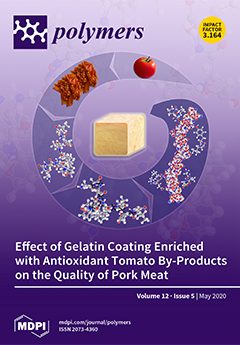The present study provides a fundamental understanding of the mechanism of action of special new phosphate glass (P-glass) systems, having different glass transition temperatures (
Tg), in polyamide 66 (PA66). Dynamic mechanical analysis (DMA) revealed that the
Tg of PA66/low
[...] Read more.
The present study provides a fundamental understanding of the mechanism of action of special new phosphate glass (P-glass) systems, having different glass transition temperatures (
Tg), in polyamide 66 (PA66). Dynamic mechanical analysis (DMA) revealed that the
Tg of PA66/low
Tg P-glass (ILT-1) was significantly shifted to a lower
Tg (65 °C), and another transition appeared at high temperature (166 °C). This was supported by a drop in the melting point and the crystallinity of the PA66/ILT-1 hybrid material as detected by differential scanning calorimetry (DSC). The dielectric spectroscopic investigation on the networks’ molecular level structural variations (
Tg and sub-
Tg relaxations) agreed very well with the DMA and DSC findings. Contrary to intermediate
Tg(IIT-3) and high
Tg P-glass (IHT-1) based materials, the PA66/ILT-1 hybrid material showed an evidence of splitting the PA66
Tg relaxations into two peaks, thus confirming a strong interaction between PA66 and ILT-1 (low
Tg P-glass). Nevertheless, the three different P-glass compositions did not show any effect on the PA66 sub-
Tg relaxations (related to the –NH
2 and –OH chain end groups’ motion).
Full article






